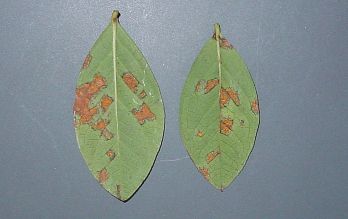Blueberry rust
Blueberry rust is a contagious plant disease caused by the fungus Thekopsora minima.
Background
Blueberry rust has been reported in Europe, Argentina, Asia, Mexico, Canada, the United States and parts of Australia.
The disease has only been found on blueberries in Australia. It has been present in parts of NSW and Queensland for many years and more recently in Victoria and Tasmania. Blueberry rust has not been found in South Australia.
Host material is prohibited from entering SA, unless it complies with Condition 1 of the Plant Quarantine Standard. Early detection and reporting of blueberry rust will help protect our blueberry industry.
Impacts
Blueberry rust is a fungal disease affecting a range of plants in the Ericaceae family, including:
- blueberries and cranberries (Vaccinium spp.)
- huckleberries (Gaylussacia spp.)
- azalea (Rhododendron spp.)
- Lyonia spp.
Millions of disease spores are quickly transported by wind, up to several hundred metres. The disease can also spread via infected plants and fruit, packaging, equipment, clothing and hands.
The spores can re-infect the original host plant as well as other blueberry plants and host species.
The fruit of infected plants is edible, but the disease causes extensive defoliation. Plant death occurs in cases of severe infection.
Management
Management
Growers can implement on-farm biosecurity measures to reduce the chance of pests and disease getting onto their properties. These include:
- using pest-free propagation material and seedlings, sourced from a reputable supplier
- putting up farm biosecurity signs on gates and fences to manage visitors coming onto your property
- avoiding sharing equipment
- keeping equipment and vehicles clean and free of plant matter
- wearing clean clothing before visiting other growers’ properties
- teaching farm workers on-farm hygiene practices, what to look for, and how to report unusual pests and diseases
- reporting unusual sign of pests and diseases.
Identification
The initial symptoms of blueberry rust appear as reddish spots on:
- the upper surfaces of young leaves
- the fruit and stems.
Surrounded by a yellow halo, these spots darken with age and may merge as the disease progresses.
Infected leaves can curl, with yellow pustules developing on the underside. These pustules spread the disease by releasing spores that infect other leaves. In severe cases, the leaves turn brown and drop prematurely.
Lifecycle
Blueberry rust produces spores throughout 5 life stages. New pustules can release spores every 10-14 days, or more rapidly under warm, wet climatic conditions.
The optimum temperature for blueberry rust is around 21°C, and new infections are unlikely when the temperature is over 30°C.
The disease can overwinter on evergreen blueberry leaves in milder climates.

